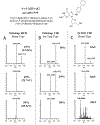Mass Spectral Library for DNA Adductomics
- PMID: 38231175
- PMCID: PMC10939812
- DOI: 10.1021/acs.chemrestox.3c00302
Mass Spectral Library for DNA Adductomics
Abstract
Endogenous electrophiles, ionizing and non-ionizing radiation, and hazardous chemicals present in the environment and diet can damage DNA by forming covalent adducts. DNA adducts can form in critical cancer driver genes and, if not repaired, may induce mutations during cell division, potentially leading to the onset of cancer. The detection and quantification of specific DNA adducts are some of the first steps in studying their role in carcinogenesis, the physiological conditions that lead to their production, and the risk assessment of exposure to specific genotoxic chemicals. Hundreds of different DNA adducts have been reported in the literature, and there is a critical need to establish a DNA adduct mass spectral database to facilitate the detection of previously observed DNA adducts and characterize newly discovered DNA adducts. We have collected synthetic DNA adduct standards from the research community, acquired MSn (n = 2, 3) fragmentation spectra using Orbitrap and Quadrupole-Time-of-Flight (Q-TOF) MS instrumentation, processed the spectral data and incorporated it into the MassBank of North America (MoNA) database, and created a DNA adduct portal Web site (https://sites.google.com/umn.edu/dnaadductportal) to serve as a central location for the DNA adduct mass spectra and metadata, including the spectral database downloadable in different formats. This spectral library should prove to be a valuable resource for the DNA adductomics community, accelerating research and improving our understanding of the role of DNA adducts in disease.
Figures




References
Publication types
MeSH terms
Substances
Grants and funding
LinkOut - more resources
Full Text Sources
Research Materials
Miscellaneous

